

|
Untitled
ca. 1940s-1950s Ink and ink wash on paper 25.6 x 20.4 cm CAS 0370-1012 |
 |
Robert Mayokok was born in 1903 in Wales, Alaska. Although he attended school only to the sixth grade, he learned to speak English quite well by studying Sears and Roebuck catalogs. From his early school years, he also recalled a painting by Rembrandt in the classroom. Although he had no idea of the artist's identity, the image inspired him to begin drawing.
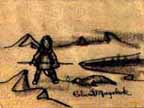 |
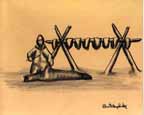 |
| Untitled ca. 1940s-1950s Ink and ink wash on bleached skin 10.2 x 7.6 cm CAS 0370-1003 |
Untitled ca. 1940s-1950s Ink and ink wash on paper 25.5 x 20.3 cm CAS 0370-1010 |
At the age of 15, Mayokok's mother died. That same year (1918), a flu epidemic struck the youth's village, killing nearly half of the 500 residents. Mayokok was sent to a reindeer camp for safety, but there he watched a close friend and the chief herder both die. He and the herder's wife returned to Wales by dogsled, but the woman also died upon their arrival. Death was everywhere and Mayokok watched helplessly as his father and grandfather also died. Weeks passed before outside help arrived to bury the dead in mass graves.
|
Untitled
ca. 1940s-1950s Ink and ink wash on paper 29.7 x 21.6 cm CAS 0370-1014 |
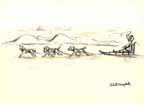 |
Following this tragic period of his life, Mayokok took a series of jobs: substitute teacher, walrus hunter, fox trapper, reindeer herder, seiner, and a gold and tin miner. From time to time he also worked as a longshoreman and a messboy on several boats.
 |
Untitled ca. 1940s-1950s Ink and ink wash on paper 20.4 x 12.8 cm CAS 0370-1005 |
As a young man, Mayokok was an adventurer. Once, while hunting walrus in the Arctic Ocean, his small boat got caught in an ice pack next to the schooner Maud. As it turned out, explorer Roald Amundsen was aboard. On another occasion, Mayokok met explorer-anthropologist Knud Rasmussen, with whom he journeyed to the Arctic and eastern Siberia aboard the two-mast schooner, Teddy Bear. In 1922-23, Mayokok took a hiatus from his nautical sojourns, and became an interpreter for the Swedish Covenant Mission on Little Diomede. He regarded this as the high point in his development as a Christian.
|
Untitled
ca. 1940s-1950s Ink and ink wash on paper 30.0 x 21.6 cm CAS 0370-1013 |
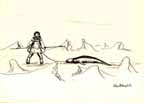 |
Mayokok also traveled to the Lower 48. As a young man he and a group of other Eskimo men traveled by boxcar with a herd of wild reindeer, stopping in various cities where one man and eight of the reindeer disembarked. Mayokok's destination was Boston, the final stop, where he trained the last group of reindeer for exhibitions. Before returning to Alaska, he visited New York and Philadelphia. In 1939, he transported another herd of reindeer to the New York World's Fair, as part of an exhibit sponsored by Alfred and Ralph Lomen of Nome. The Lomen brothers owned the Lomen Commercial Company and the Lomen Reindeer Corporation and had outfitted several Arctic and North Pole expeditions. After the fair closed, Mayokok traveled with the exhibit to several sportsmen's shows and lectured on Eskimo life.
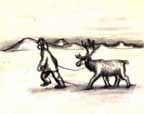 |
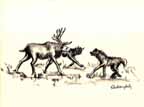 |
| Untitled ca. 1940s-1950s Ink and ink wash on paper 25.6 x 20.4 cm CAS 0370-1007 |
Untitled ca. 1940s-1950s Ink and ink wash on paper 29.5 x 21.5 cm CAS 0370-1015 |
Such exploits ended by 1947, when he was hospitalized in the Seward Sanatorium and treated for tuberculosis. His doctors removed several of his ribs in order to collapse and remove an infected lung. He remained hospitalized and separated from his family until 1950. To fend off depression, he was encouraged to write stories about Eskimo life.
 |
Untitled ca. 1940s-1950s Ink and ink wash on paper 20.4 x 12.7 cm CAS 0370-1004 |
In 1950, Mayokok decided to leave the sanatorium without being officially discharged, because he missed his family so much. He had long been an ivory carver by trade, using walrus and fossil mammoth tusks, and so he financed his return trip to Wales by selling ivory engravings. Along the way, he also took a temporary job in Fairbanks, translating newspaper and radio stories for native communities.
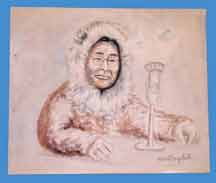 |
Untitled self-portrait ca. early 1950s Matboard, watercolor 45.8 x 38.4 cm CAS 2002-0005-0001 |
A few years later, he suffered a tubercular relapse. He was admitted to the Riverton Sanatorium in Seattle, where he was isolated for two more years. He would later credit the memory of his experiences at the Seward Sanatorium and his Christian faith with helping to fend off depression again. He turned once again to writing and also began to draw and paint seriously.
|
Untitled
ca. 1940s-1950s Ink and ink wash on paper 20.5 x 12.8 cm CAS 0370-1006 |
 |
Upon his release from the Riverton Sanatorium around 1955, Mayokok moved to Anchorage, where he sold his drawings store-to-store. His first painting was of house paint on plywood and sold for $5. His drawings and paintings are vignettes of Eskimo life, especially hunting scenes. His media included India ink, acrylics, watercolors and oils. These were applied to rabbit skin, caribou hide, paper, cowhide, velvet, and even pig skin. Only after he had mastered the basic pen and ink medium did he begin using colors.
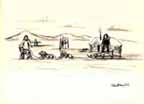 |
Untitled ca. 1940s-1950s Ink and ink wash on paper 29.8 x 21.5 cm CAS 0370-1008 |
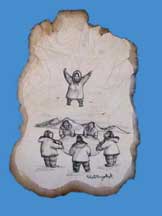 |
Untitled ca. 1950s Rabbit skin and ink 38.0 x 25.0 cm CAS 2002-0005-0003 |
Mayokok was extremely prolific during his lifetime. By his own estimates, he sold 2,000 to 3,000 drawings each year. When he had saved $500 from the sale of his artwork, he would buy a plane ticket and fly to different parts of Alaska to further promote himself.
In Anchorage, Mayokok was the resident artist at the Alaska Treasure Shop for eighteen years. He delighted in talking to visitors and telling stories. At the shop, he designed Christmas cards, stationery, wrapping paper, shopping bags, and record album covers. His sketches were commercially reproduced on pottery and chinaware (including teapots, cups and saucers, plates, mugs, vases, salt and pepper shakers, and dinner bells), as well as on wooden napkin holders, wall plaques, and other items.
|
Porcelain
teapot and mugs |
A series of stories about traditional Eskimo life, written by Mayokok for school children, was published during the 1950s and 1960s. A lengthy article entitled "My Life as an Eskimo" was published in two parts in The Alaska Sportsman. "A Marked Man: My Battle with Tuberculosis" was also written for the Alaska Sportsman, but for reasons unknown, the story remained unpublished until 1983 when it appeared in The Alaska Journal. Mayokok also illustrated several books by other artists and he, himself, was the subject of several articles and newspaper accounts.
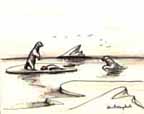 |
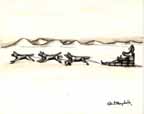 |
| Untitled ca. 1940s-1950s Ink and ink wash on paper 25.5 x 20.4 cm CAS 0370-1009 |
Untitled ca. 1940s-1950s Ink and ink wash on paper 25.6 x 20.4 cm CAS 0370-1011 |
In 1964-65, Mayokok was again employed at the New York World's Fair, presumably demonstrating his paintings and talking about his culture as he had done at the 1939 New York World's Fair. After 1970, Mayokok included three small birds in all his drawings to symbolize the Holy Trinity, a testament to his Christian faith. In 1978, several of his drawings were selected for the public areas of the new Anchorage Sheraton Hotel. Italian sculptor, Neromi, enlarged Mayokok's drawings and interpreted them in the hotel's marble walls, where they can still be seen today.
|
"Welcome
Home"
ca. 1960s Paper, watercolor and ink 50.7 x 40.6 cm CAS 2002-0005-0002 |
Robert Mayokok died in 1983. His legacy, however, continues in his art that is held in numerous public and private collections. Museums holding his work include the California Academy of Sciences, the Anchorage Museum of History and Art, the University of Alaska Museum at Fairbanks, the Ketchikan Museum, and the Kodiak Historical Society.
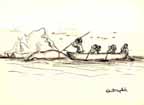 |
 |
| Untitled ca. 1940s-1950s Ink and ink wash on paper 29.8 x 21.6 cm CAS 0370-1016 |
Untitled ca. 1940s-1950s Ink and ink wash on paper 29.7 x 21.6 cm CAS 0370-1017 |
![]()
Robert Mayokok Reading List
Caswell, Helen R.
Shadows from the Singing House. Rutland: C. E. Tuttle Co., 1968.
Fair, Susan W.
"Robert Mayokok: Second-Generation Inupiaq Illustrator from Wales, Alaska." Eskimo Drawings. Suzi Jones, ed. Anchorage: Anchorage Museum of History and Art, 2003, pp. 127-134.
Frederick, Saradell Ard
"Alaskan Eskimo Art Today." The Alaska Journal, Vol. 2, No. 4, 1972, pp. 30-41.
Mayokok, Robert
"A Marked Man: My Battle with Tuberculosis." The Alaska Journal, Vol. 13, No. 4, 1983, pp. 20-26.
Eskimo Customs. Nome: Nome Nugget, 1957.
Eskimo Life. Nome: Nome Nugget, ca. 1951-1959.
Eskimo Stories. Nome: Nome Nugget, 1960.
"My Life as an Eskimo." The Alaska Sportsman. August, 1955, pp. 6-11, 29-32 and September 1955, pp. 16-20, 27-32.
"Seals." The Alaska Sportsman, May 1950, pp. 20-21, 29.
"Strong Current." The Alaska Sportsman, November 1949, pp. 18-21.
The Alaskan Eskimo. Anchorage: Instant Printing, 1960.
True Eskimo Stories. Sitka: Sitka Printing Co., 1959.
"We Caught a Whale." The Alaska Sportsman, July 1950, pp. 10-13, 24.
Mozee, Yvonne
"Robert Mayokok." The Alaska Journal, Vol. 6, No. 4, 1976, pp. 242-49.
Ray, Dorothy Jean
Graphic Arts of the Alaskan Eskimo; Native American Arts 2. Washington, DC: U. S. Dept. of the Interior, Indian Arts and Crafts Board, 1969.
A Legacy of Arctic Art. Seattle: University of Washington Press for the University of Alaska Museum, 1996.
Silook, Roger
In the Beginning. Anchorage: Anchorage Printing Co., 1970.
Ticasuk (Emily Ivanoff Brown)
The Longest Story Ever Told; Qayaq: The Magical Man. Anchorage: Alaska Pacific University Press, 1981.
Wells, James K.
Ipani Eskimos: A Cycle of Life in Nature. Anchorage: Alaska Methodist University Press, 1974.
Woodward, Kesler
Painting in the North: Alaskan Art in the Anchorage Museum of History and Art. Anchorage: Anchorage Museum of History and Art, distributed by the University of Washington Press, 1993.
Yorba, Jonathan
Drawn from the Surroundings: The Elkus Collection of Eskimo Paintings. San Francisco: A. S. Graphics, San Francisco State University, 1990.
![]()